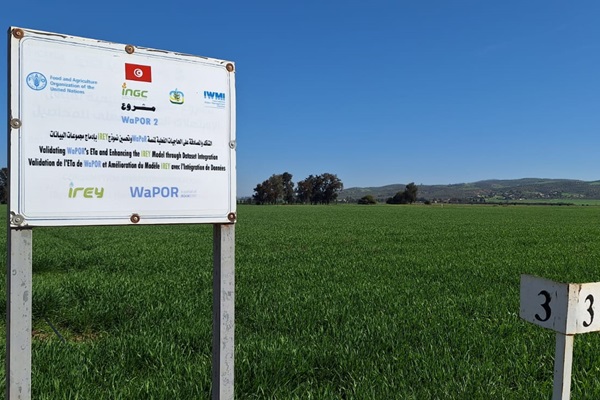 Tunisia
Tunisia
Latest news related to Tunisia

Training workshop on crop mapping in Jendouba and Kairouan, Tunisia
26/04/2024
As part of the first component of the WaPOR 2 project, focused on "Development and provision of high-resolution data (20 m)," the project's National Technical Team conducted two data collection campaigns on crop types in the targeted project areas, namely Jendouba and Kairouan. The first ...

Regional training workshop "QGIS for water productivity analysis" from 26 to 29 February 2024 in Algiers
26/02/2024
Within the framework of the implementation of the activities of the project "Monitoring land and water productivity by remote sensing WaPOR phase 2" financed by the government of the Netherlands, a regional QGIS training for water productivity analysis is organized by the Food and Ag...

WaPOR team visits high-resolution area in Jendouba, Tunisia
12/02/2024
On 8 February 2024, the WaPOR team visited the project area in Jendouba, in Tunisia. Jendouba is one of the two Tunisian high-resolution areas, available at 20m resolution on the new WaPOR portal. The International Water Management Institute (IWMI) installed humidity sensors last January, with...

WaPOR presented at the 5th Mediterranean Water Forum
08/02/2024
FAO's portal to monitor Water Productivity through Open-access of Remotely sensed derived data (WaPOR) was presented during the Digitalisation Session of the 5th Mediterranean Forum, held from 5 to 7 February in Tunis, Tunisia.
The portal was presented as an example to improve agricultu...
Resources and links
About Tunisia
Tunisia is a North African country characterised by a predominantly Mediterranean climate, with great variability ranging from humid in the extreme north to hyper-arid in the south. The long-term average annual rainfall is estimated at 207 mm/year and annual evapotranspiration varies from 1200 mm in the North to more than 1800 mm in the South (AQUASTAT, 2015). About 80% of total water withdrawals are used by agriculture for irrigation. The availability of renewable water in Tunisia is 390 m3/capita/year in 2020 (AQUASTAT, 2020) which makes it one of the countries with a water stress level of 96% in 2019, the situation having deteriorated between 2015 and that year (FAO, 2022)
As a result of global warming, rainfall continues to decline, making both rainfed and irrigated crops increasingly vulnerable and threatening the country's food security. In the face of increasing pressure on water resources, WaPOR is one of the solutions the country is turning to to make better use of these resources.
Project milestones:
April 2022: project inception workshop in Tunis
January 2023: stakeholder meeting and pilot area selection
Pilot areas:
The 3 pilot intervention sites for the WaPOR 2 project were identified in synergy with the activities carried out under the WEPS/NENA project in Tunisia. The first site is upstream of the Sidi Salem dam and located in Jendouba (North), an area with a sub-humid climate and annual rainfall of about 500 mm/year.
The second site is downstream of the Houareb dam in Kairouan (Centre), which receives about 300 mm of rainfall annually and is mainly characterised by the cultivation of olive trees and cereals, essentially in a rainy regime. The third site is in the southwest of Tunisia and includes various types of oases, where annual rainfall does not exceed 100 mm. The main production system is intensively irrigated date palm, mainly in the oases of the provinces of Tozeur and Kebili.
The project will focus on these strategic locations in order to:
- Provide support to improve the performance of irrigation systems
- Strengthen the achievements developed under the WEPSNENA project
- Strengthen national capacities in sustainable water resources management and
- Provide support for improved management of groundwater resources/oases.
WaPOR partnerships in Tunisia
The project is implemented in partnership with the Ministry of Agriculture, Hydraulic Resources and Fisheries (MARHP), coordinated by the Bureau of Planning and Hydraulic Balance (BPEH).
Other partner organisations are The Olive Tree Institute (IO), the National Institute for Major Crops (INGC), the National Institute of Meteorology (INM) and various directorates of the MARHP including
- the general directorate of Agricultural Production (DGPA),
- of Water Resources (DGRE),
- of Forests (DGF),
- of International Cooperation (D-CI),
- of Rural Engineering and Exploitation of Water Resources (DGGREE),
- of Agricultural Land Management and Conservation (DGACTA),
- of Organic Agriculture (DGAB),
- of Organization, Informatics and Management of Archival Documents (OMI),
- the National Observatory of Agriculture (ONAGRI)
- and the Agricultural Extension and Training Agency (AVFA).
The project activities are implemented in close collaboration with stakeholders who participated in the implementation of the WEPS/NENA project to ensure continuity in the efforts undertaken by that project.

© FAO/Giulio Napolitano
